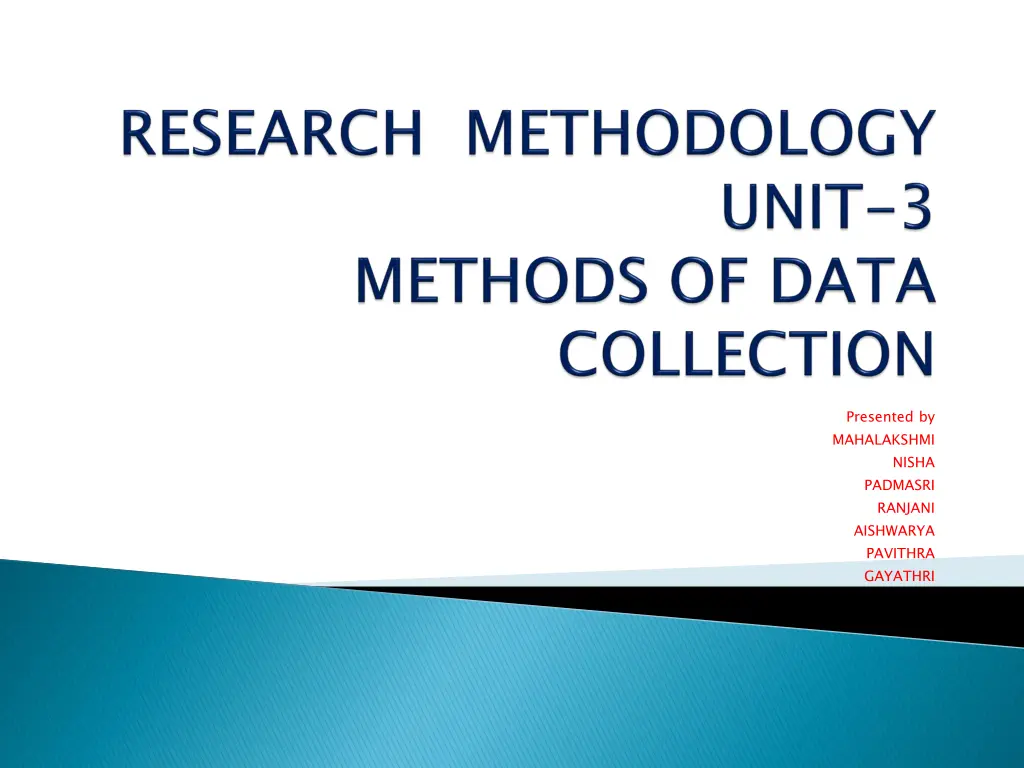
Understanding Data Collection Methods
Explore the world of data collection methods including primary data, observation techniques, interviews, and more. Learn how these methods play a crucial role in research and decision-making processes. Dive into the process of gathering and measuring information systematically to answer research questions and evaluate outcomes effectively.
Download Presentation

Please find below an Image/Link to download the presentation.
The content on the website is provided AS IS for your information and personal use only. It may not be sold, licensed, or shared on other websites without obtaining consent from the author. If you encounter any issues during the download, it is possible that the publisher has removed the file from their server.
You are allowed to download the files provided on this website for personal or commercial use, subject to the condition that they are used lawfully. All files are the property of their respective owners.
The content on the website is provided AS IS for your information and personal use only. It may not be sold, licensed, or shared on other websites without obtaining consent from the author.
E N D
Presentation Transcript
Presented by MAHALAKSHMI NISHA PADMASRI RANJANI AISHWARYA PAVITHRA GAYATHRI
Data collection is the process of gathering and measuring information on variables of interest, in an established systematic fashion that enables one to answer stated research questions, test hypotheses, and evaluate outcomes
Collection of Primary data Observation method Interview method Questionnaire method Schedule method Collection of secondary data Published data Unpublished data
The primary data are those which are collected a fresh and for the first time, and thus happen to be original in character.
The observation method involves human or mechanical observation of what people actually do or what events take place during a buying or consumption situation. Information is collected by observing process at work.
Participant Observation Non participant Observation Direct Observation Indirect Observation Control Observation Un control Observation Non behavioral Observation Behavioral Observation
An interview is generally a qualitative research technique which involves asking open ended questions to converse with respondents and collect elicit data about a subject.
Classification according to formality Formal interview Informal interview Classification according to number personal interview Group interview Classification according to purpose Diagnostic interview Treatment interview Research interview Interview to fulfill curiosity Classification according to period of contract Short contract interview Pro longed contract interview Classification according to Subject matter Qualitative interview Quantitative interview Mixed interview Focused interview Repeated interview
This method of data collection is quite popular , particularly in case of big enquiries. It is being adopted by private individuals , research workers, private and public organization and even by government
This method of data collection is very much like the collection of data through questionnaire, with little difference while lies in the fact the schedules ( porforma containing a set of questions) are being filled in by the enumerators who are specially appointed for the purpose.
Secondary data means data that are already available i.e., they refer to the data which have already been collected and analyzed by someone else .
Published data a) various publication of the central , state and local government b)Technical and trade journals c)books, magazines and newspapers. d)reports and publication e)Historical documents Unpublished data Diaries, letters, unpublished biographies and auto biographies.
Nominal scale Ordinal scale Interval scale Ratio scale
A sample refers to a smaller , manageable version of a large group .It is a subset containing the characteristic of a larger population. SAMPLING DESIGN Sampling design is a mathematical function that gives you the probability of any given sample being drawn. SAMPLING DESIGN Sampling design is a mathematical function that gives you the probability of any given sample being drawn.
Random sampling or probability sampling Non random sampling or non probabiliy sampling
Unrestricted random sampling or simple random sampling Lottery method Random number method Restricted random sampling Stratified sampling Cluster sampling Area sampling Systematic sampling Multi stage sampling Sequential sampling Size of sampling method Multi stage sampling Interpreting sampling
Convenience sampling Purposive sampling Quota sampling Snowball sampling






















